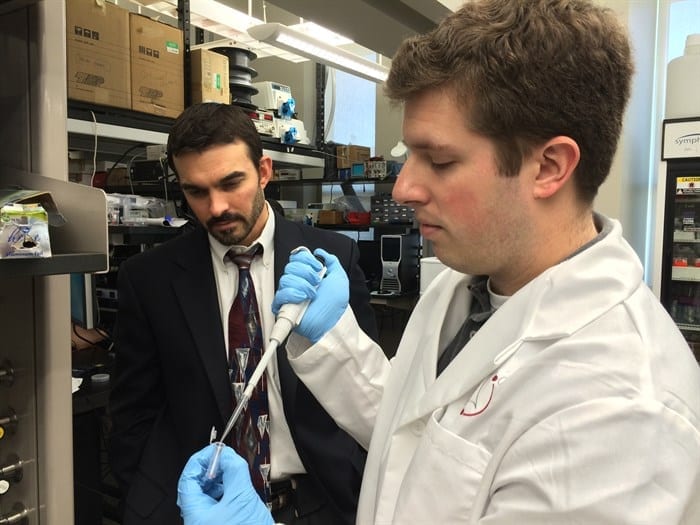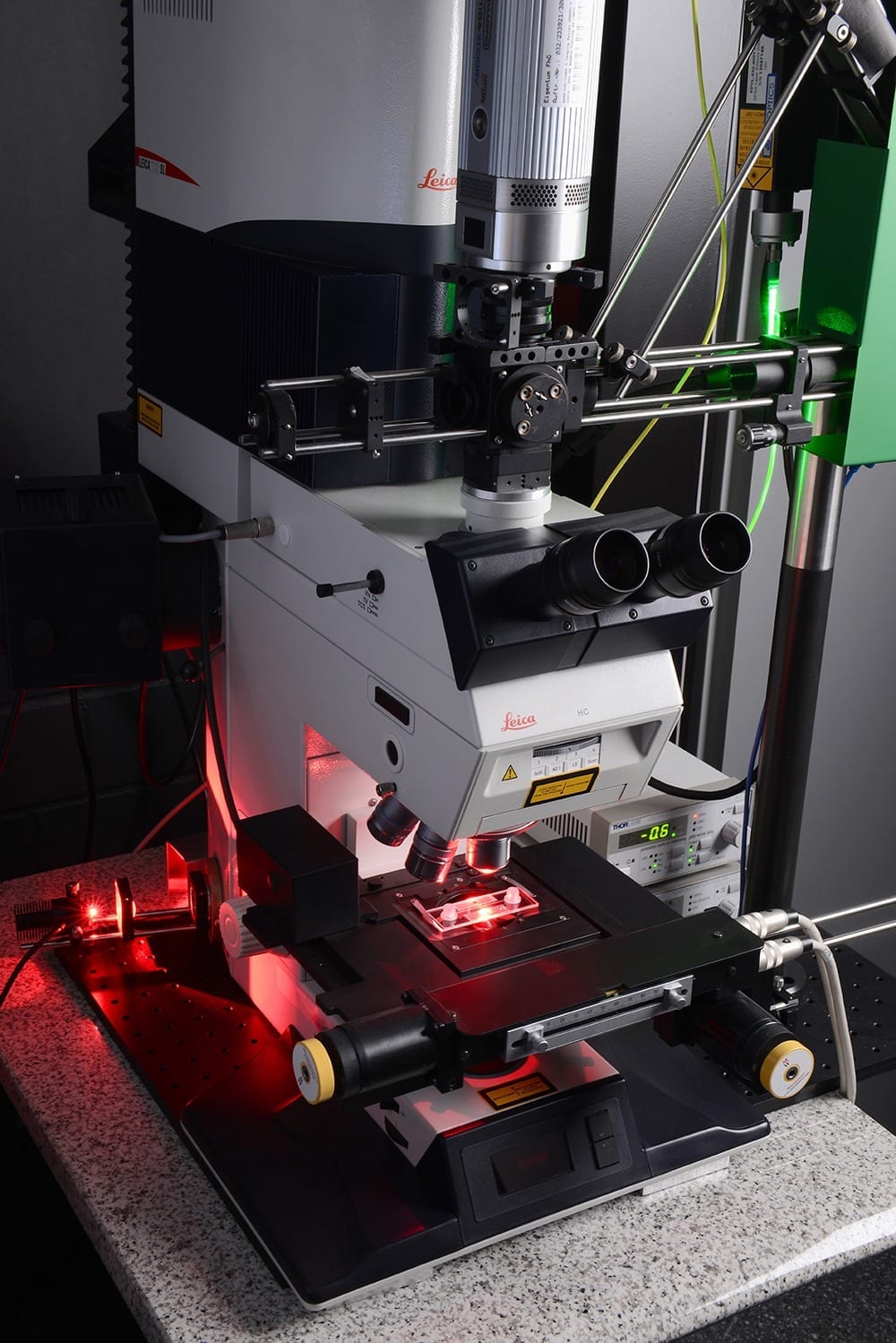
The system can lock its payload in place and control how it is released
A new injectable material designed to deliver drug therapies and sensor technology to targeted areas within the human body is being developed by a Texas A&M University biomedical engineer who says the system can lock its payload in place and control how it is released.
The research, led by Michael McShane, professor in the Department of Biomedical Engineering who specializes in biomaterials, and graduate student Jason Roberts, appears in “Journal of Materials Chemistry B.” It details the development of a carrier system embedded with microscopic capsules that act as tiny reservoirs for medicines or even sensors that would alert a person in critical instances, such as when blood-sugar levels change.
The technology, McShane notes, affords researchers a high degree of control over what is delivered to the body, where and when it is delivered and how much of it is delivered. That degree of flexibility, he says, could make the system an extremely useful tool when it comes to targeted drug delivery.
As opposed to having patients simply swallow a pill, health care professionals have long envisioned delivering specific quantities of medicines to targeted areas of the body, thereby increasing the treatment’s effectiveness while reducing side effects. In order to achieve this, a “vehicle” of sorts is needed to safely and accurately deliver the medicine to the desired location within the body.
McShane’s team, which also includes graduate student Dustin Ritter, is building that vehicle using a modified Jell-O-like substance known as a hydrogel. A hydrogel is a polymer mesh material that is typically biocompatible, meaning it allows cells within the body to conduct normal physiological processes without triggering an immune response from the host. Because of this, hydrogels are widely used in tissue engineering research, and they can be found in a number of other applications, most commonly as the material from which contact lenses are made.
Although hydrogels aren’t new, the ones employed in McShane’s carrier system aren’t typical; they’ve been enhanced. Specifically, they are embedded with tiny capsules that are significantly smaller than the width of a human hair. Each of these microcapsules serves as a reservoir or depot for the material doctors and researchers want to deliver, such as a drug.
Measuring a few microns in diameter, these porous microparticles are made from clusters of calcium carbonate nanoparticles that have been deliberately formed around a specific material to trap it inside, McShane notes. Once the desired material is trapped within the microsphere, multiple layers of polymers are wrapped around the particles, he explains. This allows for a precise and customizable control over how the microcapsule will release its contents when it interacts with its surrounding environment, McShane explains.
The system, McShane says, is not limited to drug delivery. In fact, it has shown promising results with biosensors. In these types of applications, he explains, the microcapsules carry a payload, such as a protein, that is responsive to something in the body that doctors want to measure. This measurable material is allowed to pass into the hydrogel and into the capsules where it triggers some type of optical change, he says. For example, McShane has been able to trigger a color change in the material (observable with a reader device) when pH and oxygen levels change or when blood-sugar levels fluctuate. It’s work that could translate into safer and more effective ways for people, such as those suffering from diabetes, to monitor their conditions.
The Latest on: Targeted drug delivery
[google_news title=”” keyword=”Targeted drug delivery” num_posts=”10″ blurb_length=”0″ show_thumb=”left”]
via Google News
The Latest on: Targeted drug delivery
- Biora Therapeutics Announces Completion of Multiple-Ascending Dose (MAD) Cohorts for Clinical Trial of BT-600on April 30, 2024 at 5:00 am
Dosing of all patients in the trial has been successfully completed Final results are expected to be available in late Q2 2024 SAN DIEGO, April 30, 2024 (GLOBE NEWSWIRE) -- (Nasdaq: BIOR), the ...
- Scottish inhaled drug delivery firm Nebu-Flow raises £4.7mon April 29, 2024 at 9:30 pm
Flow, a University of Glasgow spinout, has secured £4.7 million of investment to accelerate what it describes as the “next generation” of inhaled drugs for patients with respiratory disorders. Noting ...
- Scottish pioneer aiming to revolutionise inhaled drug delivery takes major stepon April 29, 2024 at 5:00 pm
READ MORE: Ian McConnell: Toxic Tory ideology and all the wrong priorities Elijah Nazarzadeh, chief executive and co-founder of Nebu-Flow, said: “Essentially, our technology provides new opportunities ...
- Glasgow firm looking to ‘revolutionise’ respiratory drug delivery gets £4.7 million injectionon April 29, 2024 at 6:33 am
We are engaged with a number of partners in the UK and North America who are currently trialling the product.” ...
- Nebu-Flow secures additional investment to accelerate next generation respiratory pharmaceuticalson April 29, 2024 at 6:07 am
Nebu-Flow has secured an additional $5.9 million of investment to accelerate the next generation of inhaled drugs for patients with respiratory disorders, which are the main cause of death and ...
- Drug delivery innovations push forth women’s healthon April 11, 2024 at 3:09 am
From nanoparticles to transdermal patches, Pharmaceutical Technology takes a look at the latest in drug delivery technologies for women's health.
- New molecular device unlocks potential for targeted drug delivery and self-healing materialson April 10, 2024 at 8:27 am
It also holds promise for self-healing materials that can repair themselves in situ when damaged, prolonging the lifespan of these materials. For example, a scratch on a phone screen. Guillaume De ...
- New molecular device unlocks potential for targeted drug delivery and self-healing materialson April 9, 2024 at 5:00 pm
Revolutionary molecular device unleashes potential for targeted drug delivery and self-healing materials. Credit: Prof De Bo, The University of Manchester ...
- Customized vectors for targeted drug deliveryon September 2, 2020 at 4:11 am
The delivery of therapeutics to target areas continues to be a challenge for drug developers. Getting drugs to their site of action is crucial to increase their efficacy and reduce toxicity.
- Drug Delivery and Molecular Sensingon August 17, 2020 at 6:15 pm
These solutions include molecular conjugates and nanoparticles for targeted drug delivery, new imaging modalities for surgical guidance and detection of drug sensitivity, and new in vitro tumor models ...
via Bing News










